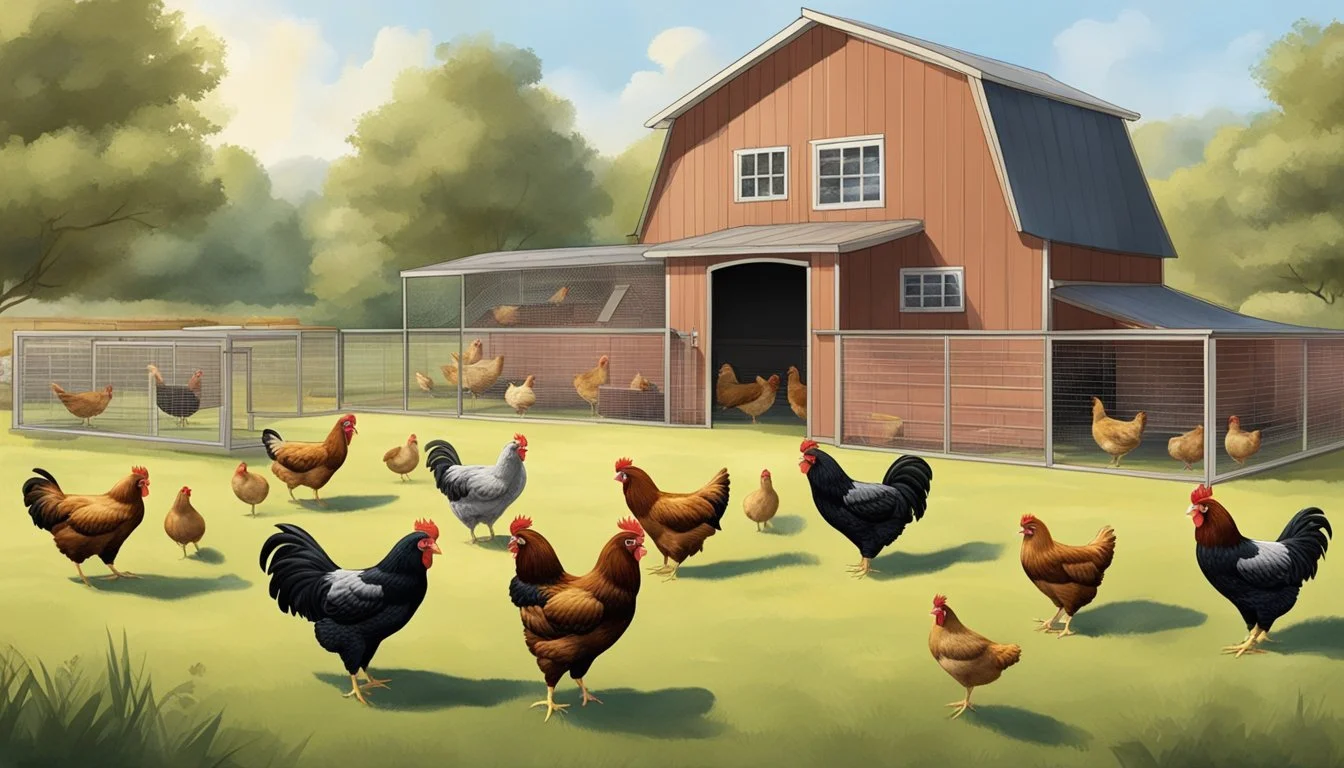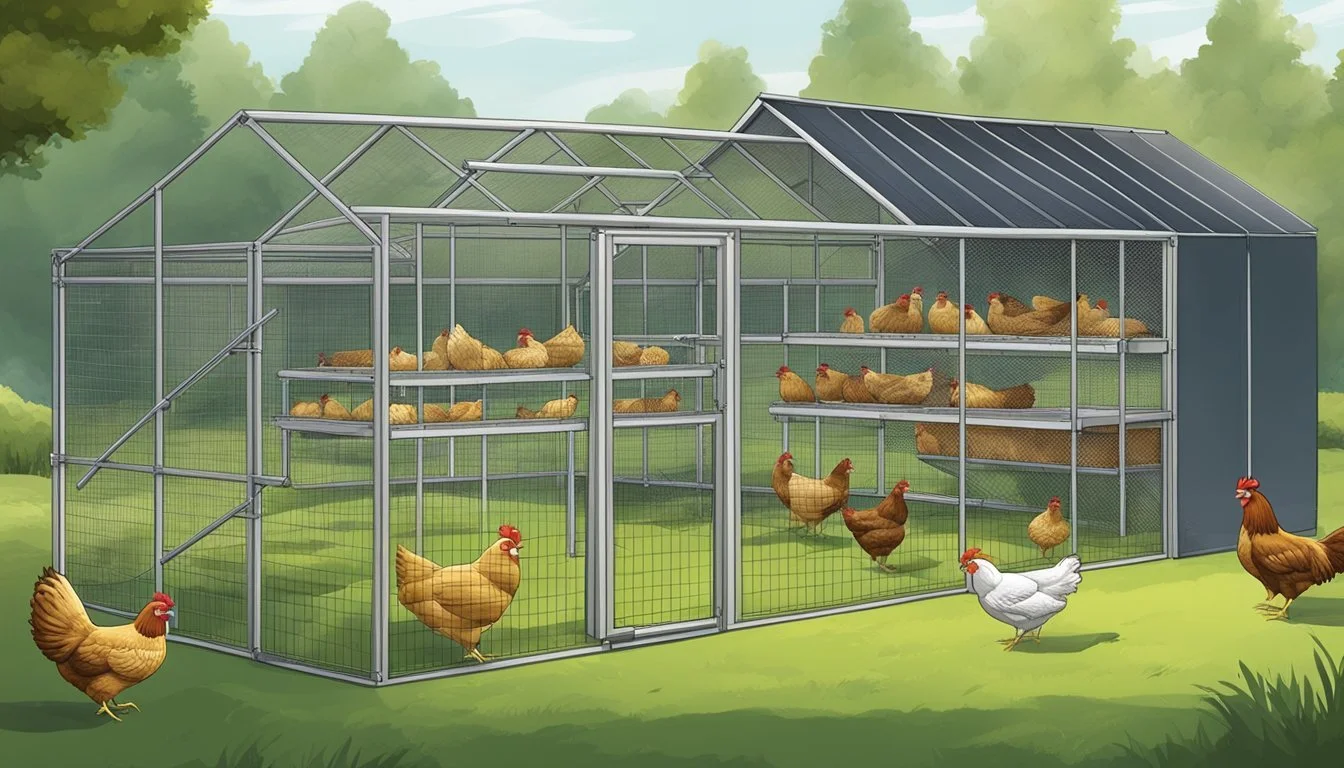How do I Manage a Small-Scale Free-Range Egg Operation
Essential Tips for Success
Managing a small-scale free-range egg operation requires thoughtful planning and a deep understanding of poultry care. Free-range egg production entails allowing chickens to roam freely, offering them a more natural environment, which can lead to healthier birds and better quality eggs. Producers must be knowledgeable about the specific needs of the flock, including shelter, nutrition, and protection from predators. It is also essential to be aware of local regulations regarding free-range systems to ensure compliance with animal health and food safety standards.
A successful small-scale layer production hinges on the ability to efficiently manage resources while maintaining high welfare standards for the chickens. This includes designing a pasture that can provide the flock with a safe and enriching outdoor space. The operation's scale should allow for close monitoring of each bird's health and productivity, ensuring any issues are quickly addressed. Careful record-keeping and budgeting are necessary to track expenses and revenues, contributing to the venture's economic sustainability.
To thrive in this endeavor, it is crucial to be both confident and adaptable. The marketplace for free-range eggs can be competitive, and consumer preferences may shift. By focusing on producing high-quality eggs, employing effective marketing strategies, and continuously seeking ways to improve operations, a small-scale free-range egg business can not only sustain itself but flourish.
Understanding the Free-Range Egg Market
Entering the free-range egg market requires an understanding of current consumer demands and market dynamics. Producers must recognize the importance of thorough market research and the identification of potentially lucrative niche markets to make informed business decisions.
Evaluating Consumer Demands
Consumer preferences are shifting towards ethically produced and healthier food options. The demand for free-range eggs is driven by a perception that they are higher in quality and more humane than conventional eggs. Consumers often associate free-range eggs with better taste, more nutrients, and a preference for supporting animal welfare. This demand is especially notable among those who prioritize organic and natural products.
Conducting Market Research
To establish a successful small-scale free-range egg operation, conducting rigorous market research is essential. It entails analyzing local market trends and preferences, which will inform the farm's production and marketing strategies. Important research activities include surveys to understand consumer behavior, competition analysis, and price benchmarking. This valuable information shapes the marketing efforts, emphasizing the unique selling points of free-range eggs in comparison to conventional alternatives.
Identifying Niche Markets
Identifying a niche market can be a springboard for success in the egg industry. Niche markets could include local gourmet restaurants, health food stores, or specific communities with an interest in sustainability and animal welfare. Providing organic eggs or catering to dietary restrictions can also carve out a special sector in the market. By targeting these areas, producers can position themselves advantageously and potentially command higher prices for their premium products.
Planning Your Egg Operation
Managing a small-scale free-range egg operation requires careful planning and a deep understanding of both the financial and regulatory aspects. Initial investments, ongoing costs, and adherence to standards for organic certification are all critical components that can determine the success of the venture.
Developing a Business Plan and Budget
The creation of a detailed business plan and budget is the foundational step in managing an egg operation. This plan intersects every aspect of the enterprise, from the procurement of hens to the setup of egg collection systems. A comprehensive business plan is not only about mapping the path to profitability but also about foreseeing challenges and planning for sustainability. The budget should account for all anticipated costs such as feed, housing, pasture management, labor, and unexpected expenses.
Considering Investment and Costs
Underneath the umbrella of budget planning falls the necessity of understanding investment and costs. This encompasses both the initial capital requirements—such as land acquisition, construction of poultry housing, and fencing—and the ongoing operational costs like feed, veterinary care, and labor. To manage these effectively, consider not just the present costs but project future increases that may impact profitability. Pennsylvania Certified Organic, for example, provides guidelines for what is required both in terms of infrastructure and ongoing operations to maintain certification.
Understanding Regulations and Certifications
Navigating regulations and certifications can be daunting, but is imperative for running a small-scale egg operation, especially if one is considering an organic enterprise. Acquiring organic enterprise certification involves following specific practices from land management to animal welfare. These practices are dictated by organizations such as Pennsylvania Certified Organic, and compliance is key to not only maintaining integrity and quality standards but also to meeting consumer expectations and securing premium pricing for the eggs produced. Additionally, understanding and following local and federal regulations are essential to ensure legality and smooth operations.
Farm Setup and Operation
Managing a small-scale free-range egg operation requires meticulous planning in setting up the farm to ensure the wellbeing of the hens and the efficiency of egg production.
Choosing the Right Location and Designing Pasture
Selecting an optimal location for a free-range egg operation is crucial. Adequate space and pasture quality influence the health and productivity of the flock. Ideally, the pasture should provide nine hens per square metre to meet free-range standards and ensure ample room for foraging. A properly designed pasture includes access to water, protection from predators, and areas equipped with shade and shelter for adverse weather conditions.
Constructing and Equipping the Coop
The coop functions as the central hub for egg laying, sleeping, and protection from elements and predators. It should provide two square feet of floor space per bird and be equipped with nests and perches. Ventilation systems are necessary to maintain air quality, while lighting is required to extend the laying period. Inside the coop, feeders and drinkers should be accessible, and straw or other appropriate litter used for bedding. Consider electricity access for lighting and the operation of watering equipment.
Establishing Biosecurity Measures
Biosecurity is paramount to safeguarding the health of the flock against diseases and pests. Implement strict access control to the layer house, disinfection points for equipment and personnel, and isolate any introduced pullets to avoid disease spread. Regularly clean and disinfect the coop, feed and watering equipment, and change the litter to maintain a hygienic environment. Secure fencing should be used to deter predators and minimize the risk of disease introduction from wild animals.
Poultry Management
Successful small-scale free-range egg operations rely on effective management of several critical aspects. From the initial stages of breeding to the ongoing nutrition and health maintenance, each plays a pivotal role in ensuring a productive flock.
Breeding and Rearing Healthy Chicks
The foundation of a robust free-range egg operation lies in breeding and rearing healthy chicks. Choosing the right breeds of chickens is essential, as some are more suited to free-range conditions. These breeds typically display strong foraging behaviors and are more resistant to common diseases. It's advisable to source chicks from NPIP (National Poultry Improvement Plan) certified hatcheries to reduce the risk of diseases such as Salmonella Pullorum and Mycoplasma.
Optimal rearing condition includes:
Adequate space for mobility and exploration
Protection from predators
Access to clean water and a starter diet rich in protein
Optimizing Feed and Nutrition
Feed and nutrition are crucial for laying hens, influencing both their health and the quality of eggs produced. A balanced diet rich in protein, calcium, and vitamins is necessary for the birds to lay strong-shelled eggs and maintain their own skeletal health. When formulating feed, aim for a crude protein content of about 16-18% to support egg production.
Key components of feed include:
Grains and seeds for energy
Greens and insects found during foraging
Supplemental feed to provide a complete nutrient profile
Implementing Effective Lighting Systems
Appropriate lighting is important in regulating the reproductive cycles of laying hens. An effective lighting system influences the birds' molting cycles and stimulates the oviduct, which can result in more consistent egg production. Light duration should be managed to provide the hens with an artificial day length of about 14-16 hours to optimize laying.
Considerations for lighting:
Natural light complemented with artificial sources
Avoiding abrupt changes in lighting which can stress birds
Maintaining Health and Preventing Diseases
Consistent health management and disease prevention are critical, especially in a free-range system where birds are more exposed to environmental pathogens. Regular sanitation of the environment, constant observation for signs of disease, and rapid response to any outbreaks are fundamental practices. Vaccinations against diseases like Salmonella Enteritidis are also key in preventing the spread within the flock and ensuring food safety.
Prevention strategies:
Regular cleaning and disinfecting of equipment and housing
Implementing all-in/all-out production methods to break disease cycles
Isolation of new or sick birds to contain potential spread
Each section of poultry management intertwines to support the overall success and sustainability of a small-scale free-range egg operation. Careful attention to these details helps ensure the health and productivity of the laying hens.
Egg Production and Collection
Efficient egg production and proper collection methods are paramount to the success of a small-scale free-range egg operation. Here is a closer look at optimizing production and implementing best practices for egg collection and storage.
Ensuring Stable Egg Production
To ensure stable egg production, one must prioritize the health and well-being of the chickens. Feeding them a balanced diet, primarily with layer mash feed, is essential. This diet should be rich in protein and calcium, promoting consistent egg laying. The design of the coop plays a significant role too. It must provide adequate shelter, nesting space, and easy access to food and water. Monitoring the flock's health regularly can prevent diseases that may hinder egg production.
Free-range conditions offer chickens the freedom to roam outdoors, which can lead to improved egg quality and size. However, environmental factors such as predation and weather must be managed. Providing secure outdoor spaces and ensuring the coop is well-ventilated, yet shielded from extreme conditions, will support continuous production of free-range eggs.
Egg Collection and Storage Practices
Egg collection should be performed at least once a day to reduce breakages and soiling of eggs. Implement a methodical approach, gathering eggs into clean containers and removing them from the coop to a cool, processing area promptly. Once collected, it is vital to maintain the quality of the eggs. This involves cleaning the eggs with care, avoiding waterlogging which might facilitate bacterial invasion.
After cleaning, the process of candling can reveal internal defects or cracks not visible to the naked eye. It's a critical step before grading eggs by size and quality. Always keep refrigerated to prolong freshness. Eggs must be stored at a consistent temperature, preventing fluctuation that can cause condensation and increase the risk of bacterial growth. This practice ensures that the eggs remain safe for consumption and can be sold at premium quality.
Marketing and Sales Strategies
Successful marketing and sales strategies for small-scale free-range egg operations hinge on differentiation and community engagement. They emphasize the unique qualities of the product while forging strong links with local businesses and consumers.
Branding and Promoting Free-Range Eggs
Branding is critical for positioning free-range eggs in the market. The operation should focus on the organic and free-range attributes, which are important selling points that resonate with health-conscious consumers seeking ethically produced foods. Effective branding could include developing a distinctive logo and packaging that emphasizes the eggs' quality and origin.
Promotional activities should target niche markets where demand for specialty products is higher. Participating in farmers markets and specialty stores can help build a loyal customer base. Additionally, educational materials explaining the benefits of free-range farming practices can be valuable for customers who are willing to pay a premium for ethically produced eggs.
Building Relationships with Local Businesses
Forging partnerships with local businesses such as dairy farmers, co-ops, and restaurants looking to feature local ingredients provides a steady demand for the eggs. Establishing contracts with local businesses helps stabilize sales and provides predictable revenue streams for the operation.
Networking with residential associations and setting up booths at roadside stands near well-trafficked loci garner community support and awareness. Many consumers prefer to support local agriculture and are more willing to purchase from operations within their community. Additionally, collaboration with feed companies could help operations gain beneficial connections and potential partnerships for co-marketing, benefiting both entities in the long run.
Analyzing and Enhancing Profitability
To effectively manage profitability in a small-scale free-range egg operation, it is crucial to understand revenue drivers and optimize operational efficiency. These efforts directly contribute to a healthier bottom line.
Understanding Revenue Streams
Small-scale egg producers must thoroughly comprehend their revenue streams. For free-range eggs, revenues are primarily derived from the sale of eggs. Factors such as whether the eggs are organic or not can influence customers’ willingness to pay higher prices. It is essential to conduct market research to set competitive prices and to understand the demand for organic eggs in the market. Producers should account for initial investment and continuously track their budget to ensure the revenue exceeds the costs associated with producing the eggs.
Assess egg price points and market preference for free-range vs. organic.
Maintain detailed records of sales volume and revenues to inform future budget decisions.
Optimizing Operation Efficiency
Maximizing operational efficiency is a cornerstone of profitability for small-scale egg operations. Producers should evaluate each aspect of their operation to minimize waste and streamline processes. Key areas include sustainable feed procurement, effective pasture management, and careful tracking of laying patterns to predict production volumes. By adopting efficient practices, they minimize costs and enhance the viability of their business.
Implement efficient management of free-range areas to reduce overgrazing and maintain egg production.
Invest in training staff in organic practices to increase the production of high-quality organic eggs and justify a premium price.
By focusing on these critical aspects, small-scale egg producers can enhance their enterprise's profitability.
Sustainable Practices and Future Outlook
Managing a small-scale free-range egg operation requires integrating environmentally conscious practices for long-term sustainability and staying informed about future market trends to adapt accordingly.
Adopting Sustainable and Environmentally Friendly Methods
Free-range egg producers are increasingly turning toward organic farming, often abiding by stringent regulations to ensure environmental and animal welfare. They focus on sustainable practices such as using organic feed, rotating pastures to avoid overgrazing, and employing natural pest control. This not only minimizes the carbon footprint but also caters to consumers wanting ethically produced eggs. These eggs are often sold in specialty stores, where consumers are looking for higher-quality, sustainably sourced products.
Anticipating Future Trends and Adjusting Strategies
Staying ahead involves monitoring future trends in the egg industry and consumer preferences. Operators must be agile, ready to adopt new technologies or shift practices to align with environmental expectations and market demands. For example, packaging made from recycled materials appeals to environmentally minded customers, and energy-efficient practices can reduce operation costs. Producers should regularly review and adapt their business strategies to remain competitive and meet the evolving standards of the industry.






